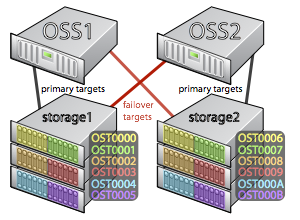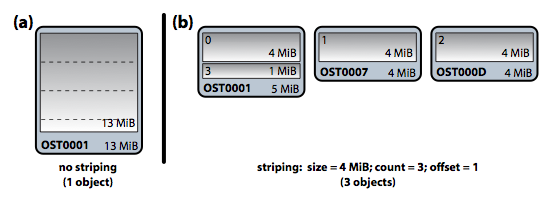This is an old revision of the document!
All About Lustre
The filesystems with which most users are familiar store data in discrete chunks called blocks on a single hard disk. Blocks have a fixed size (for example, 4 KiB) so a 1 MiB file will be split into 256 blocks (256 blocks x 4 KiB/block = 1024 KiB). Performance of this kind of filesystem depends on the speed at which blocks can be read from and written to the hard disk — (input/output, or i/o). Different kinds of disk yield differing i/o performance: a solid-state disk (SSD) will move blocks back and forth faster than a basic SATA hard disk used in a desktop computer.
Buying a better (and more expensive) disk is one way to improve i/o performance, but once the fastest, most expensive disk has been purchased this path leaves no room for further improvement. The demands of an HPC cluster with several hundred (maybe even thousands) of compute nodes quickly outpaces the speed at which a single disk can shuttle bytes back and forth. Parallelism saves the day: store the filesystem blocks on more than one disk and the i/o performance of each will sum (to a degree). For example, consider a computer that can move data to its hard disks in 1 cycle with a hard disk that requires 4 cycles to write a block. Storing four blocks to just one hard disk would require 20 cycles: 1 cycle to move the block to the disk and 4 cycles to write it, with each block waiting on the completion of the previous:
With four disks being used in parallel (example (b) above), the block writing overlaps and takes just 8 cycles to complete.
Parallel use of multiple disks is the key behind many higher-performance disk technologies. RAID (Redundant Array of Independent Disks) level 6 uses three or more disks to improve i/o performance while retaining parity copies of data1). Should one or two of the constituent disks fail, the missing data can be reconstructed using the parity copies. It is RAID-6 that forms the basic building block of the Lustre filesystem on the Mills cluster.
A Storage Node
The Mills cluster contains five storage appliances that each contain many hard disks. For example, storage1 contains 36 SATA hard disks (2 TB each) arranged as six 8 TB RAID-6 units:
Each of the six OST (Object Storage Target) units can survive the concurrent failure of one or two hard disks at the expense of storage space: the raw capacity of storage1 is 72 TB, but the data resilience afforded by RAID-6 costs a full third of that capacity (leaving 48 TB).
The storage appliances are limited in their capabilities: they only function to move blocks of data to and from the disks they contain. In an HPC cluster the storage is shared between many compute nodes. Nodes funnel their i/o requests to the shared storage system by way of the cluster's private network. A dedicated machine called an OSS (Object Storage Server) acts as the middleman between the cluster nodes and the OSTs:
In Mills, each OSS is primarily responsible for one storage appliance's OSTs. As illustrated above, OST0000 through OST0005 are serviced primarily by OSS1. If OSS1 were to fail compute nodes would no longer be able to interact with those OSTs. This situation is tempered by having each OSS act as a failover OSS for a secondary set of OSTs. If OSS1 fails, then OSS2 will take control of OST0000 through OST0005 in addition to its own OST0006 through OST000B. When OSS1 is repaired, it can retake control of its OSTs from its partner.
lfs check servers command.
The Lustre Filesystem
As illustrated thus far, each OST increases i/o performance by simultaneously moving data blocks to the six hard disks of a RAID-6 unit. Each OSS services six OSTs, accepting and interleaving six unique i/o workloads to further increase the speed with which data moves to and from the OSTs. Having multiple OSSs (and thus additional OSTs) adds yet another level of parallelism to the scheme: each OSS processes six unique i/o workloads. The agglomeration of multiple OSS nodes, each servicing one or more OST, is the basis of a Lustre filesystem2).
The benefits of a Lustre filesystem should be readily apparent from the discussion above:
- Parallelism is leveraged at multiple levels to increase i/o performance
- RAID-6 storage at the base level provides resilience
- File system capacity is not limited by hard disk size
The capacity of a Lustre filesystem is the sum of its constituent OSTs, so a Lustre filesystem's capacity can be grown by the addition of OSTs (and possibly OSSs to serve them). For example, should the 172 TB Lustre filesystem on Mills begin to approach its capacity, additional capacity could be added with zero downtime by buying and installing another OSS pair.
Further Performance Boost: Striping
Normally on a Lustre filesystem each file resides in toto on a single OST. In Lustre terminology, a file maps to a single object, and an object is a variable-size chunk of data which resides on an OST. When a program works with a file, it must direct all of its i/o requests to a single OST (and thus a single OSS).
For large files or files that are internally organized as "records3)" i/o performance can be further improved by striping the file across multiple OSTs. Striping divides a file into a set of sequential, fixed-size chunks. The stripes are distributed round-robin to N unique Lustre objects – and thus on N unique OSTs. For example, consider a 13 MiB file:
Without striping, all 13 MiB of the file resides in a single object on OST0001 (see (a) above). All i/o with respect to this file is handled by OSS1; appending 5 MiB to the file will grow the object to 18 MiB.
With a stripe count of three and size of 4 MiB, the Lustre filesystem pre-allocates three objects on unique OSTs on behalf of the file (see (b) above). The file is split into sequential segments of 4 MiB – a stripe – and the stripes are written round-robin to the objects allocated to the file. In this case, appending 5 MiB to the file will see stripe 3 extended to a full 4 MiB and a new stripe of 2 MiB added to the object on OST0007. For large files and record-style files, striping introduces another level of parallelism that can dramatically increase the performance of programs that access them.
lfs setstripe command to pre-allocate the objects for a striped file: lfs setstripe -c 4 -s 8m my_new_file.nc would create the file my_new_file.nc containing zero bytes with a stripe size (-s) of 8 MiB and striped across four objects (-c).
lfs setstripe and copying the contents of the old file into it effectively changes the data's striping pattern.



